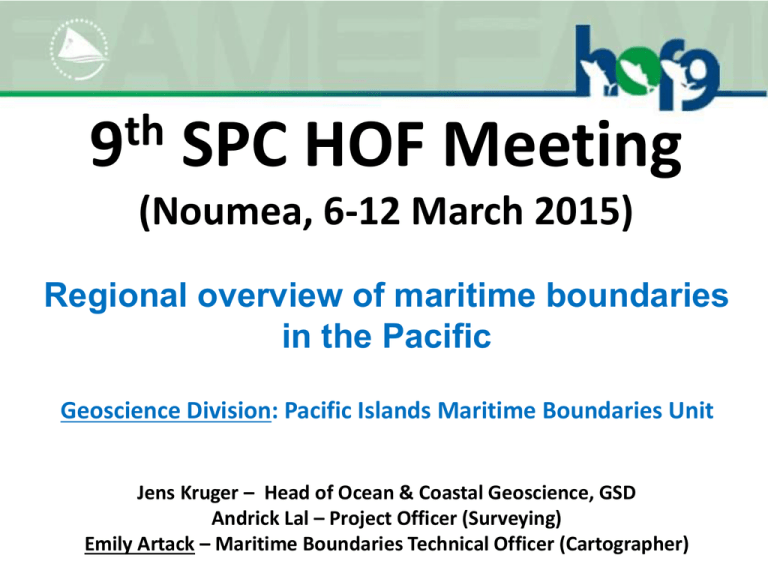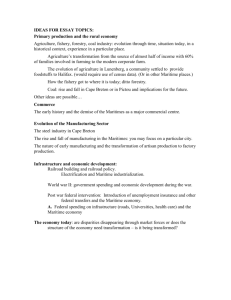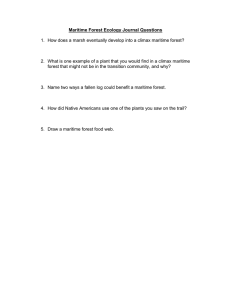9 SPC HOF Meeting th (Noumea, 6-12 March 2015)
advertisement

th 9 SPC HOF Meeting (Noumea, 6-12 March 2015) Regional overview of maritime boundaries in the Pacific Geoscience Division: Pacific Islands Maritime Boundaries Unit Jens Kruger – Head of Ocean & Coastal Geoscience, GSD Andrick Lal – Project Officer (Surveying) Emily Artack – Maritime Boundaries Technical Officer (Cartographer) Outline • Brief overview of the Regional Maritime Boundaries Project at Geoscience Division (formerly known as SOPAC) • Technical & Legal Component of activities of the Project Unit and its partners • Update on recent negotiations and endorsement of 13 treaties by PICs in the last 3 years (2012 – 2015) • Implementation of Article 76 of UNCLOS for PICs with the support from the Project and its partners • Issues faced by Project • Policy (regional scale) • Way forward for this Project UNCLOS and Maritime Boundaries • 1982 United Nations Convention on the Law of the Sea - the fundamental “constitution for the oceans”. • One of the major features of UNCLOS is the definition of a number of jurisdictional zones which refer to an area of ocean in which the coastal state has specific rights relating to the seabed, the subsoil, airspace and the water column. Maritime Boundaries and Extended Continental Shelf Territorial sea limit Contiguous Zone limit EEZ limit There are a number of criteria which determine if a coastal state has potential and the claims are subject to a technical review by the UN Commission on the Limits of the Continental Shelf Baseline development • Article 5 • Normal baseline • Except where otherwise provided in this Convention, the normal baseline for measuring the breadth of the territorial sea is the lowwater line along the coast as marked on largescale charts officially recognized by the coastal State. Baseline development • Article 6 • Reefs • In the case of islands situated on atolls or of islands having fringing reefs, the baseline for measuring the breadth of the territorial sea is the seaward low-water line of the reef, as shown by the appropriate symbol on charts officially recognized by the coastal State. Example of an island – developing the normal baseline NIUE KIRIBATI Archipelagic baselines (Article 47) State parties obligation under UNCLOS • Article 16 (para.1&2): Charts and lists of geographical coordinates for the baseline which draws the territorial sea to be shown on charts, or alternatively in a list of coordinates and this is to be given due publicity and deposit a copy with the UN. • Article 47 (para.8&9): Charts and lists of geographical coordinates for the archipelagic baselines to be shown on charts, or alternatively in a list of coordinates and this is to be given due publicity and deposit a copy with the UN. • Article 75 (para.1&2): : Charts and lists of geographical coordinates which show the outer limits of the EEZ and lines of delimitation to be shown on charts, or alternatively in a list of coordinates and this is to be given due publicity and deposit a copy with the UN. Status of Maritime Boundaries for “SOPAC” member countries (i.e. 14 project countries) in the Pacific region: 2002 1. 2. 3. 4. 3 PICs have declared their outer 200 nautical mile zones (EEZs); 5 have declared their archipelagic baselines. Approximately 37 % of the boundaries are subject to a treaty (18 of 48). None of the 14 SOPAC member countries had made submission to the UN for claims of additional seabed territories beyond the EEZs. Maritime Boundaries Unit Activities (2002 to date) Baseline/Maritime zones development Extended Continental Shelf activities (ECS) Overview of Maritime Boundaries Unit tasks 1. 2. 3. 4. Baseline development – definition of “low water line” along edge of reef, or outer most edge of outlying islands and drying reefs of an archipelago using best available datasets. Maritime Zones development – calculating the zones of the 12 nautical miles (Territorial Sea), 24 nautical miles (Contiguous Zone) and the 200 nautical miles (Exclusive Economic Zone). Technical solutions prepared with PICs for shared/overlapping EEZs Extended Continental Shelf activities (ECS) – extending the seabed territory beyond the 200 nautical miles (EEZ). Maritime Boundaries TECHNICAL & LEGAL COMPONENT Baseline/Maritime zones development 1. 2. 3. Global Positioning Systems (GPS) Field Surveys (PNG, Fiji, Kiribati) from period 2007-2011 High resolution Satellite Imagery (Geoeye 1 with spatial resolution of 50 cm) Large scale topographic maps and nautical charts, where available for some PICs Lack of legal capacity within the Project • A critical gap in the drafting new legislation (and replacing out-dated maritime spaces legislations) to allow the use of latest and more accurate technical/geodetic datasets in the development of PIC maritime boundaries work. • Given this lack of legal capacity within the Unit, the Geoscience Division sought legal advice and support from the Australian Attorney General’s Department under the Government of Australia grants in early 2011, and also with the Forum Fisheries Agency (FFA) and the Commonwealth Secretariat. In-country visits to stakeholders The Project team and the legal advisor from the Government of Australia’s Attorney General’s Department visited the following countries to conduct meetings with national stakeholders: • • • • 2011 - Niue & Tuvalu 2012 - Kiribati 2013 - Marshall Islands 2014 - Solomon Islands (organised by FFA) Outputs Baseline coordinates ready for Declarations/Public Orders Outputs Baseline coordinates ready for Declarations/Public Orders National Declaration - http://www.tuvalu-legislation.tv/ Updated Maritime Legislation in 2012 National Declaration - http://www.tuvalu-legislation.tv/ Tuvalu’s Maritime Legislation deposited with the UN in 2013 International Declaration http://www.un.org/Depts/los/LEGISLATIONANDTREATIES/STATEFILES/TUV.htm Niue’s Maritime Legislation deposited with the UN in 2014 International Declaration http://www.un.org/Depts/los/LEGISLATIONANDTREATIES/STATEFILES/NIU.htm Cook Is deposited its EEZ and MB Treaties with the UN in July 2014 International Declaration http://www.un.org/Depts/los/LEGISLATIONANDTREATIES/STATEFILES/COK.htm Updated Maritime Legislation for Kiribati deposited with the UN in December 2014 International Declaration http://www.un.org/Depts/los/LEGISLATIONANDTREATIES/STATEFILES/KIR.htm Status of Maritime Boundaries in Project countries 1. 2. 3. 4. 5. 7 PICs have declared their outer 200 nautical mile zones (EEZs); 7 PIC have declared their archipelagic baselines. Nauru, Kiribati, Tuvalu, Niue have declared its baselines, and other maritime zones (Territorial Seas, Contiguous Zone) Approximately 70 % of the boundaries are subject to a treaty (34 of 48). 10 PICs made submission to the UN for claims of additional seabed territories beyond the EEZs. Technical support for Negotiations and Development of Maritime Boundary Treaties Baseline important for negotiations : Case study: Niue and Cook Islands treaty development in 2011 & 2012 NZ Chart (published by Land Information New Zealand – LINZ – 2011) Baseline important for negotiations : Baseline –Niue verification process • High resolution satellite imagery • Ground collection of GPS points in Niue Baseline important for negotiations : Baseline – Cook Islands verification process Baseline important for negotiations : Baseline – Cook Islands (Palmerston) verification process Hydrographic chart Baseline important for negotiations : Baseline – Cook Islands (Palmerston) verification process Quick check-Google Earth Baseline important for negotiations : Baseline – Cook Islands (Palmerston) verification process Geo-eye 1 – Imagery - 2011 Baseline important for negotiations : Baselines used to construct median line in specialised software, “MarZone” Development of the Maritime Boundary Treaty between Niue and the Cook Islands Series of technical/legal meeting for negotiations • The technical and legal officers from Pacific island countries were supported by: – Geoscience Division Maritime Boundaries team – Forum Fisheries Agency Legal Advisor – Govt of Australia Attorney General’s Office Legal Advisor • Purpose: to draft Treaty documents with the Illustrative Charts agreed at officials level which were then taken to respective Capitals for official endorsements Treaty Development • Recent treaty development is an excellent example of partnerships and a willingness to pool resources and testament to the excellent relationships between Pacific Island neighbours. Treaty Development Marshall Islands, Kiribati and Nauru meeting This trilateral meeting was funded by the Forum Fisheries Agency (FFA) and held at the Geoscience Division of SPC in April 2012 Signing of the 7 Bilateral Maritime Boundaries treaties and 1 trilateral treaty at the Pacific Islands Forum Meeting in 2012 NIUE & COOK IS KIRIBATI & NAURU KIRIBATI & COOK IS KIRIBATI & TUVALU NAURU & MARSHALL IS KIRIBATI –NAURU-MARSHALL IS KIRIBATI & TOKELAU KIRIBATI & MARSHALL IS USA – Kiribati Maritime Boundary (2013) Technical and legal meeting hosted at the Geoscience Division of SPC in May 2013 This bilateral meeting was funded by the Forum Fisheries Agency (FFA) who also provided legal advice to the Kiribati team, and technical advice provided by SPC to both teams. USA – Kiribati Maritime Boundary (2013) Final Agreement – 3 maps Signing of the USA treaty with Kiribati – at the Pacific Islands Forum Meeting in Marshall Islands in September 2013 USA – FSM Maritime Boundary negotiations (2014) Technical and legal meeting hosted by the US in Hawaii in April 2014 (FSM team officials travel costs were supported by the Forum Fisheries Agency) Signing of the USA treaty with Federated States of Micronesia – at the Pacific Islands Forum Meeting in Palau in August 2014 Fiji-Tuvalu Maritime Boundary In October 2014, the PMs of Fiji and Tuvalu settled and signed a maritime boundary agreement between both countries with the technical support from the Regional Maritime Boundaries Project. Fiji-France-Tuvalu Maritime Boundary • In December 2014, the senior technical and legal officers from Fiji, Tuvalu and France (concerning Wallis & Futuna) discussed and agreed in principle to settle their respective maritime boundaries with the technical and legal support from the Regional Maritime Boundaries Project and its partners. • FFA provided funding support for the technical and legal teams from Fiji and Tuvalu to this meeting which was hosted at the Commonwealth Secretariat office in London, UK. Status of Maritime Boundaries in Project countries 1 2 1_TRIPT 3 16 5 4 6 7 15 10 11 1. 2. 3. 4. 5. 7 PICs have declared their outer 200 nautical mile zones (EEZs); 7 PIC have declared their archipelagic baselines. Nauru, Kiribati, Tuvalu, Niue have declared its baselines, and other maritime zones (Territorial Seas, Contiguous Zone) Approximately 70 % of the boundaries are subject to a treaty (34 of 48). 10 PICs made submission to the UN for claims of additional seabed territories beyond the EEZs. 8 9 12 13 2_TRIPT 14 Implementation of Article 76 of UNCLOS for the project countries Since July 2007, the Pacific Islands Maritime Boundaries Unit has been working with country teams, Geoscience Australia & other technical partners in a series of ECS claims development workshop – more than 100 days of face to face training with PICs. The Government of Australia grants and the good will of many people and institutions have been instrumental facilitating these workshops – however there is still a long way to go. Claims of Extended Continental Shelf Submitting PIC Date of Submission Status Cook Islands – concerning the Manihiki Plateau 16th April 2009 Submission being examined by the Sub Commission of the UNCLCS Fiji 20th April 2009 Submission in the queue, not yet examined by the UNCLCS Joint Submission by the FSM/SI/PNG – concerning the Ontong Java Plateau 5th May 2009 Submission being examined by the Sub Commission of the UNCLCS Palau 8th May 2009 Submission in the queue, not yet examined by the UNCLCS Tonga 11th May 2009 Submission in the queue, not yet examined by the UNCLCS Joint Submission by Tuvalu, France and New Zealand – respect to the area of the Robbie Ridge 7th December 2012 Submission in the queue, not yet examined by the UNCLCS Kiribati 24th December 2012 Submission in the queue, not yet examined by the UNCLCS FSM – in respect to Eauripik Rise 30th August 2013 Submission in the queue, not yet examined by the UNCLCS Tonga – western part of the LauColville Ridge 23rd April 2014 Submission in the queue, not yet examined by the UNCLCS Status of Maritime Boundaries in Project countries 1. 2. 3. 4. 5. 7 PICs have declared their outer 200 nautical mile zones (EEZs); 7 PIC have declared their archipelagic baselines. Nauru, Kiribati, Tuvalu, Niue have declared its baselines, and other maritime zones (Territorial Seas, Contiguous Zone) Approximately 70 % of the boundaries are subject to a treaty (34 of 48). 10 PICs made submission to the UN for claims of additional seabed territories beyond the EEZs. Overall Regional progress 2002 2015 UN Division for Ocean Affairs presentation to PICs at the recent 13th PIC Regional MB Workshop held in February 2015 Reported 66 coastal states out of 163 have fully or partially deposited their maritime boundaries information fulfilling their deposit obligations. The Pacific progressing well compared to other regions around the world. • 34 of 48 treaties formally endorsed, • 7 of 14 PICs EEZs (high seas borders) legally developed and deposited with the UN • 4 of 14 PICs deposited complete solutions, i.e. baselines, and all of its maritime zones Issues • Requires the political will and support of National Governments (ground work has taken the past 10 years of this project) • There are certain technical and legal capacity constraints within the project teams (trained staff get promoted internally) • Sovereign issue but it is heavily dependent on regional support and assistance (cost of field surveys to collect data, purchase of satellite imagery, etc.) • National Maritime Laws and Legislation needs to be reviewed and updated to reflect the technical datasets being used to develop the baselines and maritime zones • The 10 project countries who have submitted their claims for Extended Continental Shelf (under Article 76 of UNCLOS) are facing capacity constraints in the process of the defence of the these claims to the UN. Status of efforts at regional scale as compared to efforts at the national scale Why is it important? The clear definition of the limits of the maritime jurisdiction is important as it provides the legal framework for the governance of maritime space and the management of the valuable marine resources within the country’s national jurisdiction areas: • Fisheries management • Research • Deep sea minerals development • Transport • Security • Vessel monitoring • Biodiversity • Conservation Deep Sea Minerals Development Deep sea minerals development – “The Area” POLICY (at regional level) • Pacific Oceanscape Framework (2010)- to protect, manage and sustain the cultural and natural integrity of the ocean for present and future generations and for the broader global community. • 6 strategic priorities identified for the implementation: – establishing ‘jurisdictional rights and responsibilities’, – fostering ‘good ocean governance’, – supporting ‘sustainable development, management and conservation’, – promoting ‘listening, learning, liaising and leading’, – sustaining action, and – facilitating adaptation to a rapidly changing environment. POLICY (at regional level) • The Palau Declaration “The Ocean: Life & Future” Charting a Course to Sustainability (2014) – Annex B 10. “We call for strengthened regional efforts to fix baselines and maritime boundaries to ensure that the impact of climate change and sea level rise does not result in reduced jurisdiction.” • Register of PI Forum Members’ Ocean-related Initiatives associated with the Palau Ocean Declaration on Ocean: Life and Future – July 2014 Future Challenges • Increasing reports of IUU fishing activities in the region – Leaders need to formally establish their maritime boundaries (including signed treaties for overlapping EEZs) in a legal manner and deposit this information with the UN. – Critical issue given the high economic value of the fish captured from PICs EEZs, as well as in the High Seas in this region • Deep Sea Mining Implications – Application and approval of mining leases for seabed exploration and exploitation within a country’s EEZ and also in “the Area” • Declaration of marine reserves, or protected areas – Important to define the coordinates of the outer limits of the coastal state’s EEZs Way forward for this Project • Build on a common platform to share legal MB, Treaties (GIS layers) with other stakeholders (FFA –VMS, etc.) • Current funding mechanism (via the Enhancing Pacific Ocean Governance – EPOG) from Government of Australia for the regional workshops ceases in 2016 – Further discussions on possible extension of funding support • Currently, SPC and FFA (leading agency) are working together to include this important project as part of the concept note under the EDF 11 Project for next 5 years • In particular, to maintain the regional technical support (position of MB Technical Officer employed full-time) to provide advice and support to the maritime boundaries teams within the PICs for on-going negotiations Recommendations • note the priority placed on the delimitation and declaration of maritime zones in the region and their importance for ocean management and securing interests such as fisheries rights to access, conservation and management of marine areas, the exploration and mining of minerals, conservation of biological diversity, and navigation and security; • note that the majority of maritime boundaries (EEZ) in the Pacific have been negotiated and declared; and the comprehensive technical and legal support that SPC and partners continue to provide to enable PICs to delimit, publicise and deposit the remaining maritime zones; • recognise that some PICs still have significant technical and legal work to complete before they can declare their baselines and maritime zones, whilst others are in a position to move ahead with negotiations, and that the overall process under UNCLOS is country-driven and that progress depends largely on high-level national engagement; and • support SPC and particularly the work of the Maritime Boundaries Unit and consortium of partners as an appropriate and extremely effective mechanism to facilitate national efforts to finalise their maritime zones. SPC’s Project partners • PICs technical teams • Government of Australia, New Zealand for funding Project Unit activities within SPC to achieve its successful outcomes at the national levels. • Australian Government Attorney General’s Department & Forum Fisheries Agency - legal & drafting support for legislations & treaties development • Geoscience Australia & GRID Arendal – technical support • Commonwealth Secretariat - purchase of high resolution satellite imagery for baseline development, negotiations and ECS submissions support to the UN Thank you


